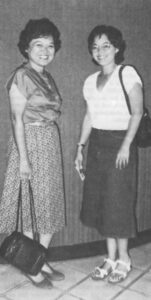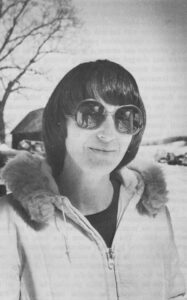Susan Stranaham
- 1983

Fellowship Title:
- Ghosts of Undone Research: Victims of environmental poisoning and how they have been compensated
Fellowship Year:
- 1983

The Law Firm That Asbestos Built
Joseph Shein It is moving day at the Philadelphia law firm of Shein and Brookman. Packing cartons spill out of offices into the hallways. The 11-man firm is about to leave its cramped quarters above a downtown bank and move to new offices in an opulent, historically certified brownstone building just off fashionable Rittenhouse Square. The 4 1/2-story structure is being restored for the law firm. Vaulted staircases and ornamental fixtures are being refurbished. The crowning jewel of the new offices, according to senior partner Joseph D. Shein, will be a restored stained glass dome that dominates the historic building. At the center of the dome is the inscription: “Wisdom Hath Builded Her House.” There is a certain irony in that, for it quite accurately can be said of Shein and his partner, Melvin Brookman: Asbestos hath builded their law firm. Until a few years ago, Shein and Brookman was a tiny firm, unknown to most of the rest of Philadelphia’s legal community. All that changed as a result of an epidemic of asbestos diseases

Downwind Deals
In late 1982 in a Salt Lake City courtroom, the United States mounted a complex and costly legal battle against a small group of its own citizens who struggled to prove that their government had knowingly subjected them and thousands of others to dangerously high levels of radiation during the nuclear weapons testing program in the 1950s and early 1960s. That exposure, these downwind residents claimed, killed their loved ones and produced an epidemic of cancer among themselves. The government denied it had harmed these people. It denied it had any responsibility to compensate them for their losses. Yet that assertion was totally contrary to a finding 2 1/2 years earlier by a high-level federal panel created especially to examine these claims. That panel unanimously concluded, in a report that was quickly labeled secret, that the government had injured some downwind residents and was morally and legally bound to compensate them. What happened in the interim? Why were the people of Utah, Nevada and Arizona–patriotic and conservative Americans who believe they were used as human

Living With Risk
In June, 1951, Patsy Takemoto Mink received her law degree and the news that she and her husband John were expecting their first child. She went to the University of Chicago’s prestigious Lying-in Hospital for her prenatal care. There, her attending physician prescribed special vitamins to ensure, as she recalls, “a healthy baby.” Unwittingly, she became a human guinea pig, as did the female child she was carrying. Not for 2 1/2 decades would she even know of her participation in a major medical experiment to test the effectiveness of the synthetic estrogen diethylstilbestrol, or DES. And when she finally did learn, in March 1976, the news came in the form of an ominous advisory from the university: As a result of the 1951 medical care, her daughter, then 24, faced an increased risk of contracting a rare form of cancer and a variety of other health problems, the extent of which remain unknown to the medical profession today. Patsy Mink and her daughter, Wendy. Mrs. Mink, who would later be elected to the United

Toxic Torts: Compensating Victims of Hazardous Substances
Pat Miller is a housewife. Alvin Green is a farmer. Martha Laird is a housewife. Salvatore Ganci is a former construction worker and Steven Sterling is a former carpenter. They live in the rich farmland of Michigan, the desolate high desert of Nevada, the modest suburbs of East Coast cities and the back country of Appalachia. They, and thousands of others throughout America, share a common experience: Unwittingly, they have been exposed to large doses of substances known to sicken and kill. They claim they have been injured. They want compensation from those responsible for poisoning them. But that, they have discovered, is extraordinarily difficult, and often impossible. Pat Miller and Alvin Green have lived through the nation’s worst manmade agricultural disaster. A highly toxic fire retardant was mixed with cattle feed and distributed across much of Michigan. Mrs. Miller and Green–along with almost everyone else in the state–are contaminated with varying levels of the chemical, polybrominated biphenyl (PBB), which has been identified as a carcinogen in animals, and thus, under federal guidelines, is a
